Chicago Loop
| The Loop | |
|---|---|
| Community area | |
| Community Area 32 – The Loop | |
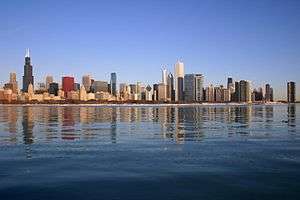 | |
 Streetmap | |
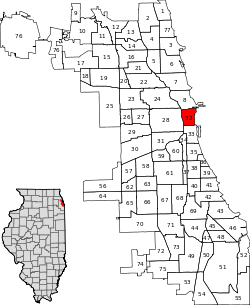 Location within the city of Chicago | |
| Coordinates: 41°53′N 87°38′W / 41.883°N 87.633°WCoordinates: 41°53′N 87°38′W / 41.883°N 87.633°W | |
| Country | United States |
| State | Illinois |
| County | Cook |
| City | Chicago |
| Neighborhoods | |
| Area | |
| • Total | 1.58 sq mi (4.09 km2) |
| Population (2015) | |
| • Total | 33,442[1] |
| (population up 104.1% from 2000) | |
| Demographics 2015[1] | |
| • White | 60.94% |
| • Black | 12.35% |
| • Hispanic | 6.45% |
| • Asian | 17.14% |
| • Other | 3.12% |
| Educational Attainment 2015[1] | |
| • High School Diploma or Higher | 92.8% |
| • Bachelor's Degree or Higher | 78.8% |
| Time zone | UTC-6 (CST) |
| • Summer (DST) | UTC-5 (CDT) |
| ZIP codes | 60601, 60602, 60603, 60604, and parts of 60605, 60606, 60607, and 60616 |
| Median household income | $93,254[1] |
| Source: U.S. Census, Record Information Services | |
The Loop is the central business district and downtown area of Chicago, Illinois, United States. It is one of the city's 77 designated community areas. The Loop is home to Chicago's commercial core, City Hall, and the seat of Cook County. In the late nineteenth century, cable car turnarounds and prominent elevated railway encircled the area, giving the Loop its name. The Loop is currently the second largest commercial business district in the United States after New York City’s Midtown.
The community area is bounded on the north and west by the Chicago River, on the east by Lake Michigan, and on the south by Roosevelt Road, although the commercial core has expanded into adjacent community areas. As a business center, some of the corporations the Loop hosts include the Chicago Mercantile Exchange (CME), the world's largest options and futures contracts open interest exchange; the headquarters of United Continental Holdings, one of the world's largest airlines; AON; The Blue Cross Blue Shield Association; Hyatt Hotels Corporation; Kraft Heinz; BorgWarner, and other major corporations. The Loop is home to 500 acre Grant Park; State Street, which hosts a historic shopping district; the Art Institute of Chicago; several theaters; and numerous subway and elevated rapid transit stations. Other institutions in the Loop include the Willis Tower, once the tallest building in the world, the Chicago Symphony Orchestra, the Lyric Opera of Chicago, the Goodman Theatre, the Joffrey Ballet, the central public Harold Washington Library, and the Chicago Cultural Center.
In what is now the Loop, on the south bank of the Chicago River, near today's Michigan Avenue Bridge, the US Army erected Fort Dearborn in 1803. It was the first settlement in the area sponsored by the United States. In 1908, Chicago addresses were made uniform by naming the intersection of State Street and Madison Street in the Loop as the division point for designating addresses, North, South, East or West on the Chicago street grid.
Etymology
It is believed the origin of the term Loop is derived from the cable car turning loops in the downtown area, and especially those of two lines that shared a loop, constructed in 1882, bounded by Van Buren, Wabash, Wells, and Lake.[2][3] Other research has concluded that "the Loop" was not used as a proper noun until after the 1895–97 construction of the Union elevated railway loop.[4]
Attractions
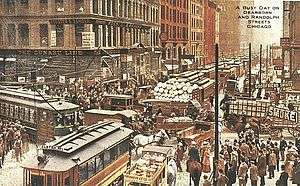
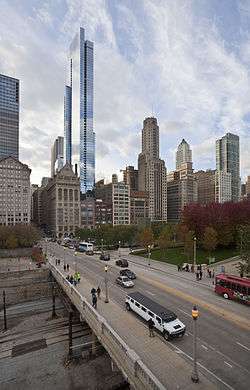
Loop architecture has been dominated by skyscrapers and high-rises since early in its history. Notable buildings include the Home Insurance Building, considered the world's first skyscraper (demolished in 1931); the Chicago Board of Trade Building, a National Historic Landmark; and Willis Tower, the world's tallest building for nearly 25 years. Some of the historic buildings in this district were instrumental in the development of towers. Chicago's street numbering system – dividing addresses into North, South, East, and West quadrants originates in the Loop at the intersection of State Street and Madison Street.
Chicago is still the nation's rail transportation hub and passenger lines once reached seven Loop-area stations by the 1890s. Transfers from one to the other was a major business for taxi drivers until the long-distance lines gave way to Amtrak in the 1970s with the majority of trains concentrated at Chicago Union Station.
This area abounds in shopping opportunities, including the Loop Retail Historic District, although it competes with the more upscale Magnificent Mile area to the north. It includes Chicago's former Marshall Field's department store location in the Marshall Field and Company Building; the original Sullivan Center Carson Pirie Scott store location (closed February 21, 2007). Chicago's Downtown Theatre District is also found within this area, along with numerous restaurants and hotels.
Chicago has a famous skyline which features many of the tallest buildings in the world as well as the Chicago Landmark Historic Michigan Boulevard District. Chicago's skyline is spaced out throughout the downtown area, giving it a graceful beautiful appearance. The Willis Tower, formerly known as the Sears Tower, the second tallest building in the Western Hemisphere, stands in the western Loop in the heart of the city's financial district, along with other buildings, such as 311 South Wacker Drive and the AT&T Corporate Center.
Chicago's third tallest building, the Aon Center, is located just south of Illinois Center. The complex is at the east end of the Loop, east of Michigan Avenue. Two Prudential Plaza is also located here, just to the west of the Aon Center.
The Loop contains a wealth of outdoor sculpture, including works by Pablo Picasso, Joan Miró, Henry Moore, Marc Chagall, Magdalena Abakanowicz, Alexander Calder, and Jean Dubuffet. Chicago's cultural heavyweights, such as the Art Institute of Chicago, the Goodman Theatre, the Chicago Theatre, the Lyric Opera at the Civic Opera House building, and the Chicago Symphony Orchestra, are also in this area, as is the historic Palmer House Hilton hotel, found on East Monroe Street.
Chicago's waterfront, which is almost exclusively recreational beach and park areas from north to south, features Grant Park in the downtown area. Grant Park is the home of Buckingham Fountain, the Petrillo Music Shell, the Grant Park Symphony (where free concerts can be enjoyed throughout the summer), and Chicago's annual two-week food festival, the Taste of Chicago, where more than 3 million people try foods from over 70 vendors. The area also hosts the annual music festival Lollapalooza which features popular alternative rock, heavy metal, EDM, hip hop and punk rock artists. Millennium Park, which is a section of Grant Park, opened in the summer of 2004 and features Frank Gehry's Jay Pritzker Pavilion, Jaume Plensa's Crown Fountain, and Anish Kapoor's Cloud Gate sculpture along Lake Michigan.
The Chicago River and its accompanying Chicago Riverwalk, which delineates the area, also provides entertainment and recreational opportunities, including the annual dyeing of the river green in honor of St. Patrick's Day. Trips down the Chicago River, including architectural tours, by commercial boat operators are great favorites with both locals and tourists alike.
Government
The Loop is the seat of Chicago's government. It is also the government seat of Cook County, Illinois and houses an office for the governor of the State of Illinois. The century old City Hall/County Building houses the chambers of the Mayor, City Council and County Board.
Across the street, the Richard J. Daley Center accommodates a famous Picasso sculpture and the state law courts. Given its proximity to government offices, the Center's plaza serves as a kind of town square for celebrations, protests and other events.
The nearby James R. Thompson Center is the city headquarters for state government, with an office for the Governor. Many state agencies have offices here, including the Illinois State Board of Education.[5]
A few blocks away is the Everett McKinley Dirksen United States Courthouse housing federal law courts and other federal government offices. This is the seat of the United States Court of Appeals for the Seventh Circuit. The Kluczynski Federal Building is across the street. The Federal Reserve Bank of Chicago is located on LaSalle Street in the heart of the financial district. The United States Postal Service operates the Loop Station Post Office at 211 South Clark Street.[6]
Fire Department
The Chicago Fire Department operates 3 Fire Stations in the Loop District:
- Engine 1, Aerial Tower 1, Ambulance 41 – 419 S. Wells St. – South Loop
- Engine 5, Truck 2, Special Operations Battalion 5-1-5, Collapse Unit 5-2-1 – 324 S. Des Plaines St. – West Loop/Near West Side
- Engine 13, Truck 6, Battalion 1, EMS Field Chief 4-5-1, Dive Master 6-8-6, SCUBA Team 6-8-7 – 259 N. Columbus Dr. – East Loop/Near East Side
| Historical population | |||
|---|---|---|---|
| Census | Pop. | %± | |
| 1930 | 7,851 | — | |
| 1940 | 6,221 | −20.8% | |
| 1950 | 7,018 | 12.8% | |
| 1960 | 4,337 | −38.2% | |
| 1970 | 4,965 | 14.5% | |
| 1980 | 6,462 | 30.2% | |
| 1990 | 11,954 | 85.0% | |
| 2000 | 16,244 | 35.9% | |
| 2010 | 29,283 | 80.3% | |
| Est. 2015 | 33,442 | 14.2% | |
| [1][7] | |||
Politics
Local
The Loop is currently a part of the 4th, 25th, and 42nd wards of the Chicago City Council, which are respectively represented by Democratic aldermen Sophia King, Daniel Solis, and Brendan Reilly.[8]
From the city's incorporation and division into wards in 1837 to the 1990s, the Loop as currently defined was at least partially contained within the 1st ward.[9] From 1891 to the 1990s it was entirely within the 1st ward and was coterminous with it between 1891 and 1901.[10] While part of the 1st ward it was represented by Democrat John Coughlin from 1892 until his death in 1938. Having served for 46 years, Coughlin was the longest-serving alderman in Chicago history until his record was broken in November 2014 by Ed Burke of the 14th ward.[11] He was from the area and owned several bathhouses in it, although in his later years he lived in the nearby Near South Side.[12] The area has not had a Republican alderman since Francis P. Gleason served alongside Coughlin from 1895 to 1897.[13] (Prior to 1923, each ward elected two aldermen in staggered two-year terms).[13]
State
In the Illinois House of Representatives the community area is roughly evenly split lengthwise between, from east to west, Districts 26, 5, and 6, represented respectively by Democrats Christian Mitchell, Juliana Stratton, and Sonya Harper, with a minuscule portion in District 9 represented by Democrat Art Turner.[14]
In the Illinois Senate most of the community area is in District 3, represented by Democrat Mattie Hunter, while a large part in the east is part of District 13, represented by Democrat Kwame Raoul, and a very small part in the west is part of District 5, represented by Democrat Patricia Van Pelt.[15]
Federal
In the US House of Representatives, the area is wholly within Illinois's 7th congressional district, which is the most Democratically-leaning district in the State of Illinois according to the Cook Partisan Voting Index with a score of D+38 and represented by Democrat Danny K. Davis.
Neighborhoods
In addition to the financial (West Loop–LaSalle Street Historic District), theatre, and jewelry (Jewelers Row District) districts, there are neighborhoods that are also part of the Loop community area.
New Eastside
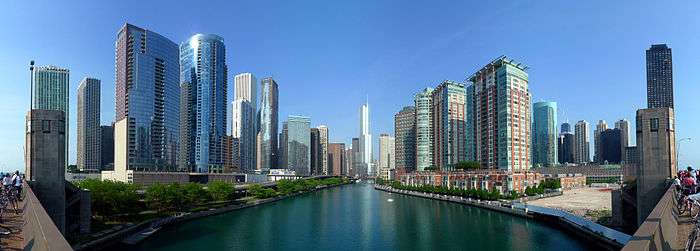
According to the 2010 census, 29,283 people live in the neighborhoods in or near the Loop. The median sale price for residential real estate was $710,000 in 2005 according to Forbes.[16] In addition to the government, financial, theatre and shopping districts, there are neighborhoods that are also part of the Loop community area. For much of its history this Section was used for Illinois Central rail yards, including the IC's Great Central Station, with commercial buildings along Michigan Avenue. The New Eastside is a mixed-use district bordered by Michigan Avenue to the west, the Chicago River to the north, Randolph Street to the south, and Lake Shore Drive to the east. It encompasses the entire Illinois Center and Lakeshore East[17] is the latest lead-developer of the 1969 Planned Development #70, as well as separate developments like Aon Center, Prudential Plaza, Park Millennium Condominium Building, Hyatt Regency Chicago, and the Fairmont Hotel. The area has a triple-level street system and is bisected by Columbus Drive. Most of this district has been developed on land that was originally water and once used by the Illinois Central Railroad rail yards. The early buildings in this district such as the Aon Center and One Prudential Plaza used airspace rights in order to build above the railyards. The New Eastside Association of Residents (NEAR) has been the recognized community representative (Illinois non-profit corporation) since 1991 and is a 501(c)(3) IRS tax-exempt organization.
The triple-level street system allows for trucks to mainly travel and make deliveries on the lower levels, keeping traffic to a minimum on the upper levels. Through north–south traffic uses Middle Columbus and the bridge over the Chicago River. East–west through traffic uses either Middle Randolph or Upper and Middle Wacker between Michigan Avenue and Lake Shore Drive.
Printer's Row
Printer's Row, also known as Printing House Row, is a neighborhood located in the southern portion of the Loop community area of Chicago. It is centered on Dearborn Street from Congress Parkway on the north to Polk Street on the south, and includes buildings along Plymouth Court on the east and Federal Street to the west. Most of the buildings in this area were built between 1886 and 1915 for house printing, publishing, and related businesses. Today, the buildings have mainly been converted into residential lofts. Part of Printer's Row is an official landmark district, called the Printing House Row District.[18] The annual Printers Row Lit Fest is held in early June along Dearborn Street.[19]
South Loop
Dearborn Station at the south end of Printers Row, is the oldest train station still standing in Chicago; it has been converted to retail and office space. Most of the area south of Congress Parkway between Lake Michigan and the Chicago River, excepting Chinatown, is referred to as the South Loop. Perceptions of the southern boundary of the neighborhood have changed as development spread south, and the name is now used as far south as 26th Street.
The neighborhood includes former railyards that have been redeveloped as new-town-in-town such as Dearborn Park and Central Station. Former warehouses and factory lofts have been converted to residential buildings, while new townhouses and highrises have been developed on vacant or underused land. A major landowner in the South Loop is Columbia College Chicago, a private school that owns 17 buildings.
South Loop is zoned to the following Chicago Schools: South Loop School and Phillips Academy High School. Jones College Prep High School, which is a selective enrollment prep school drawing students from the entire city, is also located in the South Loop.
The South Loop was historically home to vice districts, including the brothels, bars, burlesque theaters, and arcades. Inexpensive residential hotels on Van Buren and State Street made it one of the city's Skid Rows until the 1970s. One of the largest homeless shelters in the city, the Pacific Garden Mission, was located at State and Balbo from 1923 to 2007, when it moved to 1458 S. Canal St.[20]
Historic Michigan Boulevard District
The Loop also contains the Chicago Landmark Historic Michigan Boulevard District, which is the section of Michigan Avenue opposite Grant Park and Millennium Park.
Historical images and current architecture of the Chicago Loop can be found in Explore Chicago Collections, a digital repository made available by Chicago Collections archives, libraries and other cultural institutions in the city.[21]
Loop Retail Historic District
The Loop Retail Historic District is a shopping district within the Chicago Loop community area in Cook County, Illinois, United States. It is bounded by Lake Street to the north, Congress Parkway to the south, State Street to the west and Wabash Avenue to the east. The district has the highest density of National Historic Landmark, National Register of Historic Places and Chicago Landmark designated buildings in Chicago. It hosts several historic buildings including former department store flagship locations Marshall Field and Company Building (now Macy's at State Street), and the Sullivan Center (formerly Carson, Pirie, Scott and Company Building).
Economy
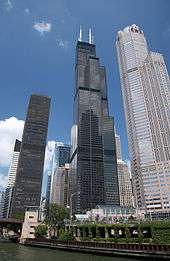
The Loop, along with the rest of downtown Chicago, is the second largest commercial business district in the United States, after New York City's Midtown Manhattan. Its financial district near LaSalle Street is home to the CME Group's Chicago Board of Trade and Chicago Mercantile Exchange.
Aon Corporation maintains its headquarters in the Aon Center.[22] Chase Bank has its commercial and retail banking headquarters in Chase Tower.[23] Exelon also has its headquarters in the Chase Tower.[24] United Airlines has its headquarters in Willis Tower. United moved its headquarters to Chicago from Elk Grove Township, Illinois in early 2007.[25] In addition, United's parent company, United Continental Holdings, also has its headquarters in Willis Tower.[26] Blue Cross and Blue Shield Association has its headquarters in the Michigan Plaza complex.[27] Sidley Austin and Morton Salt are both headquartered in the Loop.[28][29]
The Chicago Loop Alliance is located at 27 East Monroe,[30] the Chicagoland Chamber of Commerce is located in an office in the Aon Center, the French-American Chamber of Commerce in Chicago has an office in 35 East Wacker, the Netherlands Chamber of Commerce in the United States is located in an office at 303 East Wacker Drive, and the US Mexico Chamber of Commerce Mid-America Chapter is located in an office in One Prudential Plaza.[31]
Previously the grocery store company Red & White had its headquarters in the Loop.[32][33] McDonald's was headquartered in the Loop until 1971, when it moved to Oak Brook, Illinois.[34] When Bank One Corporation existed, its headquarters were in the Bank One Plaza (now Chase Tower).[35] When Amoco existed, its headquarters were in the Amoco Building (now the Aon Center).[36]
Diplomatic missions
Several countries maintain consulates in the Loop. They include Lithuania, Argentina,[37] Australia,[38] Brazil[39] Canada,[40] Costa Rica,[41] the Czech Republic,[42] Ecuador,[43] El Salvador,[44] France,[45] Guatemala,[46] Haiti,[47] India,[48] Indonesia,[49] Israel,[50] The Republic of Korea,[51] the Republic of Macedonia,[52] the Netherlands,[53] Pakistan,[54] Peru,[55] the Philippines,[56] South Africa,[57] Turkey,[58] and Venezuela.[59] In addition, the Taipei Economic and Cultural Office of the Republic of China is in the Loop.[60]
Education
Colleges and universities
Columbia College Chicago, Roosevelt University, and Tribeca Flashpoint Media Arts Academy are all located in the Loop. DePaul University also has a campus in the Loop. The University of Notre Dame & University of Illinois at Urbana–Champaign run their EMBA programs in their Chicago Campuses in the Loop.
National-Louis University is located in the historic Peoples Gas Building on Michigan Avenue across the street from the Art Institute of Chicago. The School of the Art Institute of Chicago, one of the nation's largest independent schools of art and design, is headquartered in Grant Park.
Harold Washington College is a City Colleges of Chicago community college located in the Loop. Adler School of Professional Psychology is a college located in the Loop.
Robert Morris University is located here. Argosy University has its head offices on the thirteenth floor of 205 North Michigan Avenue in Michigan Plaza.[61][62] Harrington College of Design is located at 200 West Madison Street after relocating from the Merchandise Mart.[63] Trinity Christian College offers an accelerated teaching certification program at 1550 S. State Street in the South Loop.
Spertus Institute, a center for Jewish learning & culture, is located at 610 S. Michigan Ave. Graduate level courses (Master and Doctorate) are offered in Jewish Studies, Jewish Professional Studies and Non-profit Management. Also housed in the Spertus building is Meadville Lombard Theological School which is affiliated with the Unitarian Universalist Association, a liberal, progressive seminary offering graduate level theological and ministerial training. East-West University is located at 816 S Michigan Ave.
Primary and secondary schools
Chicago Public Schools serves residents of the Loop.
Some residents are zoned to the South Loop School, while some are zoned to the Ogden School.[64] Some residents are zoned to Phillips Academy High School, while others are zoned to Wells Community Academy High School.[65]
Jones College Prep High School, a public selective enrollment school, is also located here.
Muchin College Prep, a Noble Network of Charter Schools, is also located here, in the heart of Chicago on State Street.
Notable landmarks
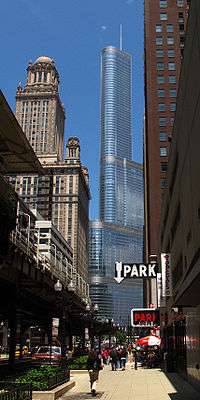
- Agora, a group of sculptures at the south end of Grant Park.[66]
- Art Institute of Chicago[67]
- Auditorium Building[68]
- Buckingham Fountain[69]
- Carbide & Carbon Building[68][70][71]
- Carson, Pirie, Scott and Company Building[68]
- Chicago Board of Trade Building[68]
- Chicago Theatre[68]
- Chicago Cultural Center[68]
- Chicago City Hall[68]
- Civic Opera House[68]
- Field Building[68]
- Fine Arts Building[68]
- Grant Park[72]
- Jewelers Row District[68]
- Mather Tower[68]
- Historic Michigan Boulevard District[68]
- Monadnock Building[68]
- The Palmer House[68]
- Printing House Row[68]
- Reliance Building[68]
- Rookery Building[68]
- Symphony Center – home of the Chicago Symphony Orchestra[73]
- Willis Tower – formerly the Sears Tower[74]
See also
References
- 1 2 3 4 5 "Community Data Snapshot - Loop" (PDF). cmap.illinois.gov. MetroPulse. Retrieved December 1, 2017.
- ↑ The Loop. Encyclopedia.chicagohistory.org. Retrieved on 2013-07-21.
- ↑ Joe Thompson, Cable Car Lines in Chicago
- ↑ Reardon, Patrick T. (2004-07-26). "It all starts downtown". Chicago Tribune. Retrieved 2016-12-17.
- ↑ "Home page". Illinois State Board of Education. Archived from the original on February 9, 2014. Retrieved March 23, 2009.
- ↑ "Post Office Location – LOOP". United States Postal Service. Archived from the original on July 18, 2012. Retrieved April 11, 2009.
- ↑ Paral, Rob. "Chicago Community Areas Historical Data". Chicago Community Areas Historical Data. Archived from the original on March 18, 2013. Retrieved August 30, 2012.
- ↑ "Aldermanic Wards for the City of Chicago" (PDF). City of Chicago. Retrieved 2 September 2018.
- ↑ "Ward Map - 11 February 1837". Chicagology. Chicagology. Retrieved 4 September 2018.
- ↑ "1900 Chicago City Ward Map". A Look at Cook. Retrieved 4 September 2018.
- ↑ "45 years in, Ald. Burke is longest serving city council member: Sneed". Chicago Sun-Times. 3 November 2014. Archived from the original on 21 February 2015. Retrieved 4 September 2018.
- ↑ FamilySearch https://www.familysearch.org/ark:/61903/3:1:33SQ-GR48-QGB?i=37&cc=1810731. Retrieved 4 September 2018. Missing or empty
|title=(help) - 1 2 "Centennial List of Mayors, City Clerks, City Attorneys, City Treasurers, and Aldermen, elected by the people of the city of Chicago, from the incorporation of the city on March 4, 1837 to March 4, 1937, arranged in alphabetical order, showing the years during which each official held office". Chicago Historical Society. Retrieved 4 September 2018.
- ↑ "Illinois House". Illinois Policy. Illinois Policy. Retrieved 4 September 2018.
- ↑ "Illinois Senate". Illinois Policy. Illinois Policy. Retrieved 4 September 2018.
- ↑ "Elements of Urbanism: Chicago".
- ↑ "Lakeshore East Map".
- ↑ "Printing House Row District". Chicago Landmarks. City of Chicago. Retrieved 1 December 2013.
- ↑ "Printers Row Lit Fest". Chicago Tribune. Retrieved 1 December 2013.
- ↑ Pacific Garden Mission, Chicago Tribune
- ↑ Long, Elizabeth. "A Single Portal to Chicago's History". The University of Chicago News. Retrieved 17 September 2016.
- ↑ "Contact Us". AON Corporation. Retrieved January 31, 2009.
- ↑ JPMorgan History | The History of Our Firm. Jpmorganchase.com. Retrieved on 2013-07-21.
- ↑ "Contact Us Archived December 30, 2009, at the Wayback Machine.." Exelon. Retrieved December 5, 2009.
- ↑ "Illinois Gov. Rod R. Blagojevich and Chicago Mayor Richard M. Daley Welcome Chicago's Hometown Airline". United Airlines. July 15, 2006. Archived from the original on June 13, 2011. Retrieved January 31, 2009.
- ↑ "Board of Directors." United Continental Holdings. November 19, 2016. "(1) writing to the Board of Directors, United Continental Holdings, Inc., c/o the Corporate Secretary's Office, Willis Tower, 233 S. Wacker Dr., Chicago, IL 60606"
- ↑ "Contact Us Archived January 10, 2007, at the Wayback Machine.." Blue Cross and Blue Shield Association. Retrieved December 23, 2009.
- ↑ "Chicago." Sidley Austin. Retrieved December 17, 2009.
- ↑ "Contact Us Archived January 7, 2010, at the Wayback Machine.." Morton Salt. Retrieved December 23, 2009.
- ↑ Choose Chicago. . Retrieved from Choose Chicago on February 22, 2018.
- ↑ "Chicago". SkyTeam. Archived from the original on January 29, 2009. Retrieved January 31, 2009.
- ↑ Life. October 26, 1953. ISSN 0024-3019. 123 (advertisement). Retrieved from Google Books on November 6, 2011. "RED & WHITE CORPORATION • 308 WEST WASHINGTON STREET CHICAGO 6, ILLINOIS"
- ↑ "cjcompmed00026-0002-color.pdf." Canadian Journal of Comparative Medicine. November 1937. Retrieved November 6, 2011. "Chicago:[...]Suite 512, Mercantile Exchange Bldg., 208 West Washington Street,[...]"
- ↑ Cross, Robert. "Inside Hamburger Central." Chicago Tribune. January 9, 1972. G18. Retrieved September 17, 2009.
- ↑ "Contact Information." Bank One Corporation. April 10, 2001. Retrieved March 31, 2010.
- ↑ "Contacts." Amoco. February 12, 1998. Retrieved March 31, 2010.
- ↑ "Argentine Consulates in the United States". Consulate-General of Argentina in New York. Archived from the original on July 23, 2008. Retrieved January 31, 2009.
- ↑ "Australian Consulate-General in Chicago, United States of America". Department of Foreign Affairs and Trade. Retrieved January 31, 2009.
- ↑ "Consulate General of Brazil in Chicago". Consulate General of Brazil in Chicago. Retrieved January 4, 2010.
- ↑ "Contact Us". Consulate-General of Canada in Chicago. Archived from the original on April 4, 2009. Retrieved January 31, 2009.
- ↑ "Consulates in the United States". Embassy of Costa Rica Washington, DC. Archived from the original on January 23, 2009. Retrieved January 31, 2009.
- ↑ "Czech criminal history record". Consulate-General of the Czech Republic in Chicago. Retrieved January 31, 2009.
- ↑ "Other Consulates in the USA". Consulate-General of Ecuador in Chicago. Archived from the original on February 5, 2009. Retrieved January 31, 2009.
- ↑ "Norte América". Consulate-General of El Salvador in Miami. Archived from the original on January 25, 2009. Retrieved January 31, 2009.
- ↑ "Address and Hours of operation". Consulate-General of France in Chicago. Retrieved January 31, 2009.
- ↑ "Home page". Consulate-General of Guatemala in Chicago. Retrieved January 31, 2009.
- ↑ "Welcome to the Consulate General of the Republic of Haiti in Chicago". Consulate-General of Haiti in Chicago. Retrieved January 31, 2009.
- ↑ "Consulate General of India, Chicago – Home". Consulate General of India, Chicago. Retrieved December 18, 2012.
- ↑ "Home page". Consulate-General of Indonesia in Chicago. Retrieved January 31, 2009.
- ↑ "General info: Mission Location". Consulate-General of Israel in Chicago. Retrieved January 31, 2009.
- ↑ http://south-korea.embassy-online.net/South-Korea-Consulate-General-Chicago.php. Missing or empty
|title=(help) - ↑ "Diplomatic missions" (in Macedonian). Ministry of Foreign Affairs of the Republic of Macedonia. Archived from the original on September 30, 2011. Retrieved May 2, 2009.
- ↑ "Home page". Consulate-General of the Netherlands in Chicago. Archived from the original on January 29, 2009. Retrieved January 31, 2009.
- ↑ "Chicago Consulate". Embassy of Pakistan in Washington, DC. Archived from the original on December 26, 2008. Retrieved January 31, 2009.
- ↑ "Jurisdicciones Consulares en USA". Consulate-General of Peru in Chicago. Archived from the original on December 22, 2008. Retrieved January 31, 2009.
- ↑ "Contact Us". Consulate-General of the Philippines in Chicago. Retrieved January 31, 2009.
- ↑ "Other Missions". Consulate-General of South Africa in New York. Archived from the original on April 20, 2009. Retrieved January 31, 2009.
- ↑ "Contact". Embassy of Turkey in Washington, D.C. Retrieved January 31, 2009.
- ↑ "Home page". Consulate-General of Venezuela in Chicago. Retrieved January 31, 2009.
- ↑ "Home". Taipei Economic and Cultural Office Chicago. Retrieved January 31, 2009.
- ↑ Baeb, Eddie (November 14, 2007). "School moving Chicago campus, HQ to Michigan Avenue". Chicago Business News. Retrieved January 31, 2009.
- ↑ "Argosy University, Chicago Campus 2nd Semester Summer Classes Start Today at New Location on Michigan Avenue". Fox Business. Archived from the original on April 15, 2009. Retrieved January 31, 2009.
- ↑ "History of Our Design School". Interiordesign.edu. Archived from the original on August 3, 2012. Retrieved June 1, 2010.
- ↑ "Near North/West/Central Elementary Schools Archived June 12, 2009, at the Wayback Machine." (Archive). Chicago Public Schools. May 17, 2013. Retrieved on May 25, 2015.
- ↑ "West/Central/South High Schools" (). Chicago Public Schools. May 17, 2013. Retrieved on May 25, 2015.
- ↑ "City of Chicago :: Agora". www.cityofchicago.org. Retrieved 2018-08-22.
- ↑ Roberta Smith (May 13, 2009). "A Grand and Intimate Modern Art Trove". The New York Times. Retrieved 2011-06-13.
- 1 2 3 4 5 6 7 8 9 10 11 12 13 14 15 16 17 18 Chicago Landmarks: Alphabetical Listing. City of Chicago's Official site. Retrieved August 5, 2011.
- ↑ Noreen S. Ahmed-Ullah (July 16, 2008). "Buckingham Fountain's $25 million renovation to begin after Labor Day". Chicago Tribune. Retrieved 2011-06-08.
- ↑ "A toast to the skyline". Chicago Tribune. Tribune Company. November 16, 2007. pp. 2:3.
- ↑ Wolfe, Gerard R. (1996). Chicago: In and Around the Loop. New York: McGraw-Hill. p. 210. ISBN 0-07-071390-1.
- ↑ Liza Kaufman Hogan (November 5, 2008). "Chicago's Grant Park turns into jubilation park". CNN. Retrieved 2008-11-11.
- ↑ Orchestra Hall Archived June 5, 2011, at the Wayback Machine., NHL Database, National Historic Landmarks Program. Retrieved February 10, 2007.
- ↑ "Sears Tower Being Renamed". Chicago Breaking News. March 12, 2009
External links
| Wikimedia Commons has media related to Chicago Loop. |